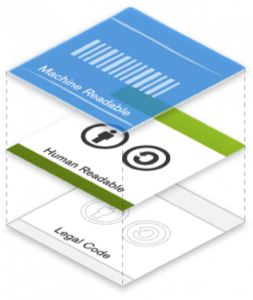- Time-syncing a musical work to a moving image. Think, using background music for a video.
- Altering or remixing a work or works into something new.
- Fixing spelling or grammatical errors
- Format-shifting. For example, downloading a digital file and sharing it as a paper copy.
- Combining unaltered works into a collection. For example, creating a course pack of assigned readings.
- Using an unaltered image as part of a larger work. Remember, you must still cite the image.
A: Check out this chart of permissions from Creative Commons.
A. Check out this handy chart of compatible CC licenses.
A. Yes in consultation with this guide on licensing 3-D printing materials.
A: You may notify them they have 30 days to remedy. Here is some additional advice as well.
A: You have 30 days to remedy it. If you do not, then you will lose your rights to use the licensed work. Learn more here.
A. Not in the U.S. Please reach out to your librarian for tips and procedures for respecting U.S. federal educational privacy rights.
A: No. Exercise your rights to fair use and dealing when using CC licensed materials.
A: Check out Creative Commons' FAQ list.
 Building on open education, open access, and other sharing countercultures, attorney Lawrence Lessig and like-minded folks started Creative Commons (CC). A nonprofit organization and global network of movers and shakers making it easier to share knowledge with their legal tools, like the Creative Commons (CC) licenses and public domain tools. CC licenses allows creators to retain copyright and give permissions for others to freely share, reuse, and remix and more via the internet and other formats.
Building on open education, open access, and other sharing countercultures, attorney Lawrence Lessig and like-minded folks started Creative Commons (CC). A nonprofit organization and global network of movers and shakers making it easier to share knowledge with their legal tools, like the Creative Commons (CC) licenses and public domain tools. CC licenses allows creators to retain copyright and give permissions for others to freely share, reuse, and remix and more via the internet and other formats.
CC licenses are designed to co-exist with copyright and its sister laws like fair use. Only works that are copyrightable are eligible for a CC licenses. CC licenses do not cover trademarked or patented works and are not recommended for use with software.
A creator may only apply a CC license to work for which they own the copyright, such as a civilian employee at USAFA. If you do not own the copyright to a work, then you cannot apply a license to it. For example, if you are active duty military or a Cadet at USAFA, then your work is automatically placed in the Public Domain as government information, and you cannot apply a CC license.
A creator does not give up their copyrights when applying a CC license to their work, unless they place it in the public domain. Rather than retain all their rights under copyright or give up all their rights to the public domain, CC licensing allows creators to retain some rights and clearly communicate those rights to users.
Once you apply a CC license, the license is irrevocable, though. So be highly reflective of what license you apply and what types of licensed work you use.
Big takeaway: Think of CC licenses as a communication tool between creators and users. Applying a CC license to your copyrighted work signals what users can and cannot do with the work, such as adapting or sharing or profiting from derivatives (modifications of the original work). Read more below to discover these permissions and more about how CC licenses work.
 CC licenses work well because they are designed to be understood by lawyers and non-lawyers as well as computers. Let's break down what this means exactly.
CC licenses work well because they are designed to be understood by lawyers and non-lawyers as well as computers. Let's break down what this means exactly.
Layer 1: The legal code is the foundational layer of CC licenses because attorneys use this "fine print" to legally uphold the terms of CC licenses in a court of law. The legal terms are available in multiple languages for international use. The legal terms lay out proper attribution form, terms of the irrevocable license, and procedures for violations. To read an example of the legal code, see the CC BY license.
Layer 2: The common deeds spells out the legal code in simple language for (non-lawyer) humans. For instance, the CC BY-NC-ND terms clearly state that a user is free to share (CC) and must attribute the original creator (BY), must not use a work for commercial purposes (NC), and may not "remix, transform, or build upon the material" to create any derivatives (ND).
Layer 3: the machine readable and final layer is a standardized way for software to read CC Rights Expression Language or metadata for the CC licenses. The machine readable layer makes it possible to search for something in the Creative Commons library or by usage rights in Google or
 |
BY: The attribution symbol requires users cite the creator of the work. Unless using a CC-0 license, all other CC licenses include the CC-BY or attribution requirement. |
 |
NC: The noncommercial element restricts people from using a work primarily for financial gain. The element pertains to the usage of the work not the person or entity using the work. For-profit or commercial agencies may use NC works for not-for-profit purposes. It also does not restrict, for instance, a campus book store for charging students for printing costs of an NC licensed work. Read Creative Commons' report on NC licenses for more information. |
 |
SA: ShareAlike requires adaptors to license their works under the same license. |
 |
ND: No Derivatives does not necessarily restrict someone from adapting or modifying an ND work. It does, however, restrict adapters from sharing such derivatives from other people. ND, however, does not restrict licensees from putting it into or using it in another format. In other words, if you find an image licensed under ND, you may not modify and share it, but you may be able to use it as an intact image for your work. |
Creative Commons combines the four different elements of licenses to create six license types. The license types are how you can clearly communicate your copyrights. That is, how you can tell people how they may use your work. Read through each of the below. If you need additional help applying a license, reach out to the scholarly communications librarian or use the Creative Commons tool for choosing a license.
 |
CC-BY: The attribution license type allows others to share, remix, reuse, and profit commercially from your work as long as they credit you. |
 |
CC-BY-SA: This attribution license type allows others to use your work much as they could with a basic CC-BY license. It stipulates, however, that any derivatives, that is remixes or modifications, be shared under the same license, CC-BY-SA. |
 |
CC-BY-ND: The addition of the No Derivatives element restricts people from sharing any derivatives they make of your work. The BY still mandates that they must attribute your work if remixing it for private use or including it unaltered in another work. |
 |
CC-BY-NC: This license allows others to share, remix, and reuse your work but prevents them from profiting financially from your work. Note, the NC does not prevent you from profiting from your work, and is a tool to retain your sole commercial rights. |
 |
CC-BY-NC-SA: The ShareAlike aspect of this license mandates that others can reuse, remix, and modify your work. But they cannot do so for commercial purposes and any derivatives they create must be licensed as CC-BY-NC-SA. |
 |
CC-BY-NC-ND: This license type places the greatest amount of restrictions on users. Essentially, users can access, use, and share unaltered copies of your work without financial profit. They cannot share any derivatives they make. |
Remember: even with the most restrictive CC license, CC-BY-NC-ND, fair use and other laws of copyright still stand. Think of CC-BY-NC-ND of being the closest CC license to a standard copyright. So you can still read, quote and cite, and use the source for educational purposes.
Creative Commons also has symbols for items in the Public Domain. Unlike the above six licenses, the Public Domain licenses do not allow you to communicate your copyrights, but allows you to release your copyrights or acknowledges when an item is no longer copyrighted.
In other words, use CC licenses to communicate copyright but do not attempt to rewrite copyright with a CC license.
|
|
CC0 legally places creators' works in the public domain worldwide. The fine print of this license works has some loopholes to address instances when some countries do not allow works to enter the public domain. Cultural heritage sites, such as libraries, museums, and archives, use CC0 to waive any legal rights to copies they make public. |
 |
The Public Domain Mark also places works in the public domain but does not have any legal weight. Cultural heritage sites use it to mark items known to have no copyright and to be in the public domain. |
"Creative Commons licenses" by Karna Younger is licensed under a CC-BY-NC 4.0.
"About the Licenses" by Creative Commons. CC BY 4.0.
"Unit 3: Anatomy of a CC License" by Creative Commons. CC BY 4.0.
"The appearance of hyperlinks on this web site along with the views and opinions of authors, products or services contained therein does not constitute endorsement by the U.S. Government, DoD, USAF, or USAFA. These sites are used solely for authorized activities and information that supports the organization's mission. The U.S. Air Force and the Air Force Academy do not exercise any editorial control over the information you may find at these link locations. Such links are provided consistent with the stated purpose of this DoD Web Site."
U.S. Air Force Academy, USAFA, CO 80840, (719) 333-2590 DSN: 333-2590, Updated 8 Apr 2018
Privacy & Security Notice /
External Link Disclaimer /
Contact USAFA Webmaster /
Accessibility Section 508/
FOIA